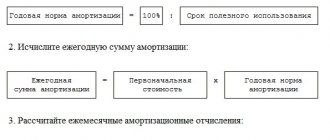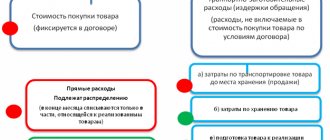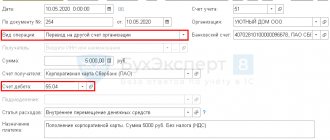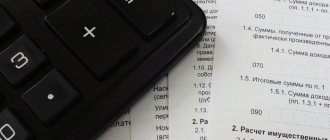The main reasons for writing off furniture (tables, chairs, etc.) - all about taxes
Furniture is an element that every enterprise has. And if it does not directly participate in economic activity, then it has an indirect impact on it, since it requires periodic maintenance and incurring costs.
Furniture in an enterprise means not only classic office “new things”, but also everything that has a similar design - furnishings for retail premises, workshops, warehouses, catering establishments.
To write off furniture structures, several characteristics are taken into account.
The following are the general points:
- external defects (dirt, cracks, scratches, fading);
- desire for renewal (purchase of more status furniture, reorganization of the enterprise).
- loss of functionality (breakage, deformation);
The service life of furniture depends on the manufacturer, type and variety and is determined at the factory.
Furniture manufacturers have an obligation to establish this parameter in accordance with Decree of the Government of the Russian Federation of June 16, 1997 No. 720. After this period, the structures can be dangerous not only for people in the room and working with them, but also for the environment.
Decision-making traditionally occurs when the estimated cost of repair or restoration is commensurate with or greater than the cost of acquiring new items equipped with identical characteristics. Traditionally, this verdict is made by a special commission responsible for conducting an inventory.
Furniture that is used in commercial premises, be it restaurants, hotels, offices, shops, factories, becomes unusable much earlier and more often than what happens with structures at home.
During intensive use, individual units may break down, become irreversibly dirty, tear, scratch, or fade. Data that such property has become unfit for use is recorded when compiling inventory papers or discovering similar facts.
The documentation shows the types of damage, for example:
- deformation of individual elements as a result of excessive heating, high humidity, and wetness;
- wear of the upholstery as a result of the influence of the temporary factor;
- breakdown of the main functioning mechanisms that facilitated the operation of structures;
- defects associated with facing furniture surfaces.
- breakdown of the frame part, including legs, tabletops, seats, walls, armrests, doors;
All these damages imply the need to write off and note these aspects in the act. There is only one condition: the costs of restoration exceed the costs of purchasing new units.
Information about how much repair work will cost can be obtained from organizations that specialize in this type of service.
The desire to change the environment is normal and natural not only for households, but also for entrepreneurs.
In this case, write-off occurs not because the furniture has lost its properties, but due to a change in the design concept of the object or the transition of the business to a new status with a higher level of prestige.
Reasons for writing off furniture in the write-off act
Furniture is an element that every enterprise has.
And if it does not directly participate in economic activity, then it has an indirect influence on it, i.e.
j. requires periodic maintenance and costs. The content of the article
Furniture in an enterprise means not only classic office “new things”, but also everything that has a similar design - furnishings for retail premises, workshops, warehouses, catering establishments.
To write off furniture structures, several characteristics are taken into account.
The following are the general points:
- desire for renewal (purchase of more status furniture, reorganization of the enterprise).
- external defects (dirt, cracks, scratches, fading);
- loss of functionality (breakage, deformation);
The service life of furniture depends on the manufacturer, type and variety and is determined at the factory.
Furniture manufacturers have an obligation to set this parameter in accordance with. After this period, the structures can be dangerous not only for people in the room and working with them, but also for the environment. Decision-making traditionally occurs when the estimated cost of repair or restoration is commensurate with or greater than the cost of acquiring new items equipped with identical characteristics.
Traditionally, this verdict is made by a special commission responsible for conducting an inventory.
Furniture that is used in commercial premises, be it restaurants, hotels, offices, shops, factories, becomes unusable much earlier and more often than what happens with structures at home. During intensive use, individual units may break down, become irreversibly dirty, tear, scratch, or fade.
Data that such property has become unfit for use is recorded when compiling inventory papers or discovering similar facts.
The documentation shows the types of damage, for example:
- breakdown of the main functioning mechanisms that facilitated the operation of structures;
- breakdown of the frame part, including legs, tabletops, seats, walls, armrests, doors;
- wear of the upholstery as a result of the influence of the temporary factor;
- defects associated with facing furniture surfaces.
- deformation of individual elements as a result of excessive heating, high humidity, and wetness;
All these damages imply the need to write off and note these aspects in the act. There is only one condition: the costs of restoration exceed the costs of purchasing new units. Information about how much repair work will cost can be obtained from organizations that specialize in this type of service.
The desire to change the environment is normal and natural not only for households, but also for entrepreneurs.
On the norms for loss (breakage) of household mirrors during transportation, storage and sale
ORDER of December 28, 1988 N 213O I order: 1.
To approve and put into effect from January 1, 1989 the attached Standards for losses (breakage) of household mirrors during transportation, storage and sale, as well as the Procedure for applying these Standards, developed by the Ukrainian Research Institute of Trade and Public Catering (UkrNIITOP) and agreed with the Ministry of Finance USSR. Job code 87414.65.1.06.2. The ministries of trade of the union republics, the Central Union, ministries and departments with a trade network, bring to subordinate organizations and enterprises the norms for losses (breakage) of household mirrors approved by this order and the procedure for applying these norms and ensure their correct application.3.
Consider the order of the USSR Ministry of Trade dated January 27, 1981 N 26 as no longer in force
“On the Norms for losses (breakage) of household mirrors upon receipt at rail and non-rail warehouses, during transportation by motor vehicles, storage and sale”
.Minister K.Z.Tereh APPROVED by order of the Ministry of Trade of the USSR dated December 28, 1988 N 213 (as a percentage of the amount of the consignment of goods) 1. For wholesale trade enterprises: 1.1. Upon receipt of mirrors at rail warehouses: 1.1.1. upon acceptance for “audible” break0.3 1.1.2. when carrying out 100% piece-by-piece acceptance 1.0 1.2. When receiving mirrors transported by two modes of transport: by rail in wagons and containers with their subsequent transportation by road 1.2.1. when accepting for “audible” break 0.6 For retail trade enterprises: 2.1. Upon receipt of mirrors from the manufacturer, transported by two types of transport: by rail in wagons and containers with subsequent transportation by road transport2.0 2.2. Upon receipt of mirrors transported by road from the manufacturer or from wholesale warehouses after piece-by-piece inspection 1.0 2.3. Upon receipt of mirrors from the warehouse of the wholesale base in the manufacturer's packaging: 2.3.1.
transported by road2.2 2.3.2. transported by two types of transport 3.2 3. When storing and selling mirrors in retail enterprises, as a percentage of the amount of goods sold during the inter-inventory period 0.1 Note. When cargo travels to the Far North, remote and mountainous areas, the norms for losses (breakage) of mirrors established to write off losses during transportation increase by 50%.
When transporting mirrors only by water transport, the norms of losses (breakage) established in clause 1.1 of the Standards are applied in the amount of 50%. APPROVED by order of the Ministry of Trade of the USSR dated December 28, 1988 N 213 1.
The norms for losses (breakage) of household mirrors of domestic production resulting from transportation, storage and sale are maximum and are applied by wholesale and retail state and cooperative trade enterprises.2. Loss (battle) norms apply
How to recycle an old mirror if it is intact?
You can sell your old mirror.
If you avoid barbaric methods, then the products in question can:
- Give to other people;
- Offer to charities;
- Sell to those who need to equip new commercial spaces.
For reference! On average, 10-11 million m2 of mirrors are produced in Russia every month.
The demand for these products is constant, with slight fluctuations observed from time to time. Therefore, you can offer citizens a second-hand mirror. The problem is that there are superstitions among the population. Their meaning is that misfortunes and illnesses can be transmitted through mirrors. Another option is that through them you can take away happiness and good luck. How justified they are is a matter of faith.
For those who ignore signs and superstitions, the above options will help not only to dispose of the mirror competently and correctly, but also to make money from it. The option of selling these products for equipping commercial spaces is especially suitable. New enterprises are trying to save on the purchase of equipment and repairs and are looking for cheap options. Used mirrors are just that case.
The sale advertisement can be posted on online trading platforms. The most common is Avito. A good description, indication of parameters, as well as detailed photographs and a price significantly lower than the market price - all this sells in a matter of weeks or days. Additionally, you can order advertising on the service. It is not expensive, its cost can be taken into account in the price of mirrors, but due to this, the ad will be in the TOP for some time.
The sale option is suitable for both those who have large volumes of mirrors left and those who have a single product. The main requirement is that only a whole mirror is sold, not a broken one.
Preparing to transport the mirror
If anyone is interested in purchasing face mirrors, you will have to prepare them for transportation.
Transportation will also be required in case of disposal for recycling. To do this you need:
- Cover the surface (back and front walls) of the product with tape, thereby preventing the scattering of small pieces in case of breakage;
- Wrap with bubble wrap. An old blanket will do;
- Each mirror is sealed and wrapped separately, with foam rubber, fabric or polystyrene placed between them;
- The products are placed in a box in several pieces so that the points of contact are protected with rags or other shock-absorbing material.
It is recommended to place no more than 2-3 mirrors in each package. They are heavy, and excessive load increases the risk that the products will not reach their destination and will break.
It makes sense to sell products locally and avoid shipping. Otherwise, after discussing all the nuances and risks with the buyer, take a partial or full prepayment from him. Even if some mirror breaks along the way, and half of the requested amount remains on hand, this is much more than the processing enterprises will offer.
Marriage on the mirror: types and reasons
Defects on a mirror most often result from failure to keep the glass surface immaculately clean.
Masters who silver mirrors must work in thin rubber gloves, since the slightest touch of the hand to the surface of the glass while carrying or laying it on the table leads to the formation of stains on the mirror. During the silvering process, it is important to carefully prepare the glass for processing: 1) if the edges of the glass surface are not sufficiently washed to remove grease stains that formed during carrying and laying the glass, the silver liquid will not “set” at the edges; 2) if the surface is poorly degreased, the layer of silver will be uneven and will easily separate from the surface of the glass in the form of a film; 3) if you do not properly clean (rinse) the glass surface from traces of tin dichloride, spots or matte stripes several millimeters wide will begin to appear along the edges of the mirror. Small black dots may also appear; 4) if liquid is unevenly removed from the glass during the silvering process or during drying, the silver layer will separate (slide) along the edges as blackened, destroyed material.
Excess drops of moisture can collect and linger on the edges and corners of the glass, destroying the silver plating; 5) if the surface of the glass is damaged during mechanical or chemical treatment, the particles of sodium sulfide and sodium sulfate contained in the glass will react with silver, and black or brown spots will appear on the surface of the mirror - traces of sulfur. To avoid this, before silvering the mirror, wash it with a 10% hot soda solution. Typical problems in the silvering process that lead to defective mirrors:
- dusty, humid, poorly ventilated room where processing is carried out.
In this case, small black dots and small holes may appear on the mirror inside the silver layer over the entire surface of the glass, the so-called.
"net"; failure to comply with strict temperature conditions in the room (25-26° for cold silvering and 30-32° for hot silvering).
This leads to the deposition of an inhomogeneous layer of metallic silver on the glass and product defects; insufficient cleanliness of sponges, suede, felt and other materials used for washing and cleaning the glass surface.
As a result, bluish stripes and lines appear on the mirror; violation of the silver plating recipe and established rules for preparing solutions. Due to an incorrect algorithm for mixing solutions, metallic silver settles in the form of a powder, which is removed from the surface of the glass at the slightest touch.
Preparation of solutions without strict adherence to the established recipe leads to the peeling of the film of metallic silver from the surface of the glass in the form of flakes. poor quality of the reagents and materials used. Low-quality products used to process glass cause solid stains in the form of circles and dots of a dark brown, brown or grayish color to appear on the mirror.
As follows from the above, glass silvering is a rather difficult and technological process.
Mirror with yellow spots and stains
High temperature of solutions. There is little ammonia in the silver solution. Poor quality distilled water (lots of salts). Activation was not carried out properly - after applying stannous chloride, dissolved was poured on. water not evenly or insufficiently over time.
Add ammonia to the silver solution (the solution should be completely transparent). Cool the solutions to room temperature (about 20 degrees). Monitor the timing and uniform application of solutions and dispensers. water during activation (at least 3 minutes).
Mirror defects for write-off. Disposal of furniture
Do you want to renovate your office space?
Have you moved or decided to update your employees’ workspaces because the existing furniture is no longer suitable? Then you have found what you were looking for! Despite the fact that old furniture is essentially garbage that belongs in a landfill, you cannot simply throw away inventory that is on the balance sheet of an enterprise.
The write-off of furniture in an organization and its subsequent liquidation require the participation of specialized companies that ensure competent organization of the process and provide all the necessary documents. Our company has extensive experience in the field of write-off and recycling.
All our specialists are highly qualified and will be happy to help you in solving problems with writing off furniture in any volume. The speed of our work will also pleasantly surprise you. As practice shows, office furniture, as a result of intensive and often careless use, becomes unusable much more often than one might imagine.
The main reasons for write-offs are usually the following:
- significant adverse changes in the appearance of furniture due to prolonged or careless use;
- functional damage that creates inconvenience or danger for subsequent operation.
In practice, it looks something like this: cracks and chips appear on the tables, the surface darkens, and drawers become loose.
Chairs, especially “computer” ones, have handles that break, the fabric surface gets worn out, or the rollers are damaged, which reduces the stability of the chair and, as a result, threatens the safety of the employee.
Cabinets often “suffer” from swelling of the veneer and destruction of the varnish surface. Naturally, such furniture loses its presentable appearance, significantly reduces the comfort of employees, the respectable appearance of the office and, as a rule, needs to be replaced. However, before updating inventory, it is necessary to make room for it and write off office furniture in accordance with regulations and legislation.
Please note: we serve both commercial firms and enterprises, and also write off furniture in budgetary institutions. As a rule, the procedure for writing off municipal property is regulated by the managers of fixed assets of these organizations, and in order to remove this or that inventory from the balance sheet, a resolution of the current commission of the institution is often sufficient. However, in cases where write-off implies further liquidation, a specialized disposal company may be involved to carry out complex work, which includes not only write-off, but also subsequent disposal, so by contacting us, you receive comprehensive qualified assistance from specialists, and accordingly you can be confident that all work will be completed efficiently and on time. In addition to standard office furniture, we write off upholstered furniture: this request is most often made by boarding houses, sanatoriums, hotels, both public and private. As a result of negligence, negligent treatment
Safe disposal
Disposal of a safe in organizations when performing this manipulation for the first time raises many questions. What can you do with a metal box: sell it for scrap, flatten it?
How to write off a fixed asset and register a business transaction?
The decision to dispose of the safe is made by the commission. To confirm this need, a technical examination is carried out. Its results are documented in an act approved by the head of the company or institution. The reasons for moral or physical wear and tear must be indicated. For example, in the following wording: “The safe is not subject to further use due to physical wear and tear. Repair is not practical."
The act is needed to prepare the write-off act.
After completing the documents, it is possible to directly dispose of the equipment, namely, transfer:
- to a company that has a disposal license,
- for scrap metal.
The accounting department handles write-offs.
Contact a specialized company so that not only the recycling, but also the removal of old equipment will be handled by professionals. Old safes weigh differently depending on the model. Even small boxes are very heavy. But you need to take the safe out of the building and load it onto the transport. Do not load it yourself - it is dangerous to health and life. You can also damage your car with heavy equipment.
Professional employees offer to quickly lower the safe, carry it and lift it into the car, secure it and take it away for disposal. As a rule, 4-6 people are needed for all manipulations with safes.
There are also lighter safes. For example, modern burglar-resistant and fire-resistant structures are assembled from composite materials.
Reasons for writing off the mirror
Main types of furniture defects
Furniture defects can be divided into several types based on the reasons for their occurrence:
- Natural aging of furniture.
- Defects by furniture manufacturers are associated with the use of low-quality materials, as well as non-compliance with technological regimes and technical requirements;
- Defects in the operation of transportation and storage of furniture;
It is worth saying a little more about these defects and, if possible, the reasons for their occurrence.
As already mentioned, the appearance of these defects is mainly due to the use of low-quality materials in production, non-compliance with technological regimes and technical requirements, in other words, careless or insufficiently qualified furniture manufacturing. Damage and defects of this type do not appear immediately, usually after 3-4 months
- and others
- peeling off mosaic elements
- Loosening or destruction of tenon joints;
- curliness (a defect in the structure of wood, expressed in a tortuous or random arrangement of wood fibers)
- uneven width and thickness of furniture parts
- Curvature, discrepancy between geometric dimensions
- Cross-grain (a defect in the structure of wood, expressed in the deviation of the direction of wood fibers from the longitudinal axis)
- Presence of knots and cracks, uneven color
- Peeling and cracking of the facing layer;
- swelling of chipboard when used instead of more expensive and moisture-resistant MDF
- Cracking and warping (changes in the shape of lumber, blanks and parts when they dry or moisten) of panel elements;
It is possible to avoid the appearance of such defects only by carefully inspecting the furniture after manufacture or during purchase.
Such defects include:
- play in excess of the norm for drawers
- Ripples, dark and light spots and bubbles on the varnish
- cracks in furniture parts
- and others
- warping of door components and parts
- Wood erasing
- unsticking tenon joints
- clearances of doors, drawers, etc.
- Dents, abrasions, scratches, snags, chips
- Color change
Careful use and care of furniture prevents the occurrence of most of these defects. Furniture made from valuable wood requires special care (maintaining a certain temperature and required humidity in the room).
- pest damage
- destruction of the cladding of decorative elements of the finishing coating
- mold, rot
- loosening, falling out of screws
- straightening bent parts
- breaking
- loss of parts
- discoloration, dullness of varnished surfaces
- discoloration of facial surfaces
- and others
- weakening of the structure
So, the most common defects and damage to furniture are listed above, but the list is far from complete.
Reasons for writing off the mirror
admin 05/27/2021 Articles Contents
- Safe disposal
- Documentation of commodity losses from combat, scrap, damage to goods
- Accounting entries Dt Kt
- New entries:
- Accounting entries Dt Kt
- Accounting entries Dt Kt
- Accounting entries Dt Kt
- Accounting entries Dt Kt
Documentation of commodity losses from breakage, scrap, damage to goods Breakage, scrap, damage occurs as a result of improper storage, careless handling of goods, theft, etc. For write-off, a commission is created consisting of the director of the enterprise, the financially responsible person, a representative of the public, and, if necessary, a representative of the sanitary supervision.
The commission draws up an act on damage, damage, scrap of inventory items (form No. TORG-15) in triplicate. The act indicates the composition of the commission, the name of the missing goods, quantity, price, amount, cause of loss, defects of the goods, as well as the possibility of its further use (sold at actual sales prices, destroyed, taken to a landfill, given to livestock feed, etc. ).
If the product has only partially lost quality, the commission discounts it. In this case, the act indicates two prices: before and after the markdown, as well as the amount of the markdown.
When registering damage or loss of quality of goods arising for one reason or another that are not subject to further sale, an act of write-off of goods (form No. TORG-16) is applied, which is drawn up in 3 copies and signed by members of the commission authorized for this by the head of the organization. If necessary, the act is drawn up with the participation of a representative of sanitary or other supervision.
The first copy is sent to the accounting department and is the basis for writing off losses from the financially responsible person, the second copy remains in the department, the third – with the financially responsible person. The acts are approved by the head of the enterprise. After approval of the act, the financially responsible person writes off the amount of damage according to the product report.
The delivery of goods for processing or to collective farms for livestock feed is documented with a consignment note. Damaged goods are destroyed in the presence of the commission in order to avoid repeated write-off and activation. Accounting entries Dt Kt 1.
For the amount of battle damage, scrap at various prices. When writing off the amount of damage, damage, scrap due to distribution costs at purchase prices.
The amount of the difference between the various and purchase prices for damaged goods using the “red reversal” method. 94 44 94 41/2 94 42 2. When writing off the amount of damage, damage, scrap at the expense of the financially responsible person at purchase prices. For the amount of the trade allowance at the expense of the financially responsible person.
73/2 73/2 94 98/4 At the enterprise of the Kesovogorsk regional industrial enterprise, the norms of natural loss are not applied, there is no write-off of containers and write-off of commodity losses. Accounting for the weight of containers The goods must be capitalized by weight, net, but in some cases it is impossible to immediately determine it, therefore the net weight (net) is determined by excluding the mass of the container indicated on the marking (stencil) from the gross weight.
Mirror - DVR TWO CAMERAS, G-SENSOR, PERFECT VIEW, PARKTONIC, FULL - HD SHOOTING! 54% discount applies var newDt = new Date(); newDt.setDate(newDt.getDate() + 0); var newDt2 = new Date(); newDt2.setDate(newDt2.getDate() + 1); document.writeln(newDt.getDate() + " and "); document.write(newDt2.getDate() + » » + month[day.getMonth()]); !
Place an order A VIDEO mirror in the modern world is a vital thing for every motorist.
There are two problems in Russia - fools and roads. If we are unable to fight the roads with technical means, we simply have to protect ourselves from fools.
You may not believe it, but it is a car VIDEO RECORDER that can dot the i’s in all controversial situations on the road (road accident, illegal stop by POLICE officers, etc.).
And believe me, even if you drive super carefully and safely, you will never be insured against a “fool”!
Viewing angle: 170 degrees
54% discount applies var newDt = new Date(); newDt.setDate(newDt.getDate() + 0); var newDt2 = new Date(); newDt2.setDate(newDt2.getDate() + 1); document.writeln(newDt.getDate() + " and "); document.write(newdt2.getdate() + » » + month[day.getmonth()]); !>
Parking function for convenient parking
High resolution Full HD 1920x1080p
Rear view camera for convenient parking
G-sensor - records acceleration and deceleration
Parallel recording - front and rear
What breaks in DSLRs Over time, increasingly high-quality cameras are becoming available to the average user. A class of SLR cameras has appeared for amateurs and beginners. This has given rise to a huge number of different models that are sold in huge quantities.
Naturally, nothing lasts forever and many experience breakdowns. Any camera user who is at least somewhat seriously involved in photography should have an understanding of possible malfunctions and how to prevent these malfunctions.
The price reduction for photographic equipment did not come without compromising quality. Most Nikon kit lenses and many cheap optics have plastic mounts. It is the fastening that is the weakest point.
Light lenses do not put much strain on the mount, but heavier optics such as Nikkor 18-135, 18-105 have a lot of weight and a light load can damage the mount. Sometimes even a slight blow to the lens with your hand can cause damage. In workshops you can replace the mount, but it will also be plastic.
More expensive optics use metal in the mounting elements.
For Canon, Sigma and Tamron lenses, the cable that connects the camera electronics and the aperture drive motor often breaks.
The train operates in extreme conditions.
During zooming, it folds at an angle from 90° to 180°. After about a year of active use, the cable breaks. It can be treated by replacing the cable. A fairly simple repair, since you can find an analogue of the original cable.
Sony also has problems. The most common is the inability to focus.
The lens unit crackles and moves non-stop, but focusing does not occur.
This is caused by broken teeth on the focusing gear. These gears are made of plastic. The crown can be restored or replaced. Ultrasonic motors began to be used in lenses not so long ago. This technology is very convenient and productive. Focusing speed and accuracy have increased, noise has decreased significantly, but new problems have also appeared that are not typical of older autofocus drive systems. First of all, USM motors do not like dirt.
Dust that gets between the rotor and the collector changes the conditions of interaction between these two elements and the operation of the system is disrupted. Because of this, the engine starts to run jerkily. If the contamination is severe, the motor stops altogether.
A design flaw in many USM motors is that the rotating element itself bores the groove and generates debris.
This can be fixed in a workshop.
To ensure the functionality of some lenses, an accurate feedback system about the position of the focusing unit is required.
Magnetoresistor heads provide the necessary functionality (MR-head). These heads slide along the surface of the magnetic tape.
In this mechanism, the bracket may become deformed and the magnetic tape may be erased. Such damage cannot be repaired. You need to buy a new head.
In carcasses, mainly only the moving part of the mirror and shutter breaks. Manufacturers
Recycling a broken mirror
It is impossible to sell it.
Individuals can only throw it in a trash container, and business entities will also have to dispose of it. Disadvantage - a broken product excludes its secondary use; sale or gratuitous transfer is impossible. The advantage is that it is easier to transport, and individuals avoid hassles with utility companies and the regional waste management operator.
Therefore, if difficulties arise with intact mirrors, they are deliberately broken. For this it is recommended:
- Take precautions - wear safety glasses and gloves;
- Wrap the product in an old blanket or wrap it with tape;
- Break it with a hammer or other heavy object into small pieces.
As a result, there are small parts of the mirror in the blanket or on the tape, which are conveniently placed in a trash can or a separate durable bag (you can use a double one). Vacuum the surface around the place where the mirror broke and wipe with a damp cloth. Then all that remains is to dispose of the broken mirror through a recycling facility (for legal entities and individual entrepreneurs) or a regional operator, simply throwing it in the trash.
Rules for the use of glass products and mirrors
> When transporting goods, glass elements must be installed vertically, with their ends in the direction of transport, and secured in such a way as to prevent the possibility of them moving and swinging during transportation. When unpacking containers, storing, installing the product and during its operation, mutual contact, strong shocks, contact of glass with hard objects, and blows to the end are not allowed.
Installation of mirrors using adhesive material must be carried out on a flat surface, ensuring that the adhesive material is applied in an equal thickness over the entire area of the mirror.
Even minor discrepancies can cause distortion in the image on the reflective layer.
It is not allowed to place the glass sheet on the floor or other supporting surface without using a rubber or other backing to ensure the safety of the product. Installation work on installing glass and mirror products should be carried out only by organizations specializing in this field in order to avoid adverse consequences.
When installing glass and mirror products, it is necessary to follow the rules and safety precautions for performing work, as well as ensure maximum protection of the skin and head. Furniture made of glass and mirrors should be placed in a room with a relative humidity of 45-55%.
A significant deviation from the specified regime leads to a significant deterioration in the consumer qualities of the product. Moving furniture made of glass and mirrors is allowed if the load is evenly distributed on all supporting elements of the furniture. It is not recommended to place cabinet furniture closer than 1 m from heating devices and other heat sources, as well as under direct influence of heat and sunlight.
It is not allowed to place hot objects on glass products or mirrors without a heat-insulating gasket. It is not allowed to operate glass products and mirrors glued with UV-curing glue in conditions of high humidity.
The surfaces of glass products should be wiped with a soft cloth or sponge using glass cleaner. Before using cleaning and washing products, you must read the instructions for use. To avoid scratches, moving solid objects without lifting them off the glass surface is not allowed.
To care for decorative elements (frosted or stained glass patterns, painted surfaces), it is necessary to clean dry or wet with a soft cloth without using chemically active cleaning agents.
To care for elements made of wood or metal, you should use special products designed for these purposes. The load on the surface of the furniture must be distributed evenly over the entire area, following the principle: the heaviest objects should be placed closer to the supports, the lightest objects - to the center of the surface.
Rules for the use of glass products and mirrors
When transporting goods, glass elements must be installed vertically, with their ends in the direction of transport, and secured in such a way as to prevent the possibility of them moving and swinging during transportation. When unpacking containers, storing, installing the product and during its operation, mutual contact of glass, strong shocks, contact of glass with hard objects, and blows to the end are not allowed.
Installation of mirrors using adhesive material must be carried out on a flat surface, ensuring that the adhesive material is applied in an equal thickness over the entire area of the mirror.
Even minor discrepancies can cause distortion in the image on the reflective layer.
It is not allowed to place the glass sheet on the floor or other supporting surface without using a rubber or other backing to ensure the safety of the product. Installation work on installing glass and mirror products should be carried out only by organizations specializing in this field in order to avoid adverse consequences.
When installing glass and mirror products, it is necessary to follow the rules and safety precautions for performing work, as well as ensure maximum protection of the skin and head. Furniture made of glass and mirrors should be placed in a room with a relative humidity of 45-55%. A significant deviation from the specified regime leads to a significant deterioration in the consumer qualities of the product.
Moving furniture made of glass and mirrors is allowed if the load is evenly distributed on all supporting elements of the furniture.
It is not recommended to place cabinet furniture closer than 1 m from heating devices and other heat sources, as well as under direct influence of heat and sunlight.
It is not allowed to place hot objects on glass products or mirrors without a heat-insulating gasket. It is not allowed to operate glass products and mirrors glued with UV-curing glue in conditions of high humidity.
The surfaces of glass products should be wiped with a soft cloth or sponge using glass cleaner. Before using cleaning and washing products, you must read the instructions for use. To avoid scratches, moving solid objects without lifting them off the glass surface is not allowed.
To care for decorative elements (frosted or stained glass patterns, painted surfaces), it is necessary to clean dry or wet with a soft cloth without using chemically active cleaning agents.
To care for elements made of wood or metal, you should use special products designed for these purposes. Due to the presence of nickel-sulfide inclusions in the chemical composition, products made from them are prone to spontaneous destruction.
To minimize the risk of self-destruction
Reasons and grounds for writing off material assets
- /
- /
March 16, 2021 0 Rating Share We recommend a selection The reasons for writing off material assets can be varied: from identified defects to obsolescence. Find out more in our material about the reasons and grounds for writing off valuables. Material assets are subject to write-off if they:
- Consumed during the normal production process in the manufacture of final products or semi-finished products.
- They have lost their original properties and cannot be used for their intended purpose.
In the first case, for the write-off of each batch of raw materials and materials, there is no need for a special written permission from management - the write-off is carried out according to established standards, which must be justified and approved by the head of the enterprise.
The write-off process has its own characteristics, which will be discussed in one of the subsequent sections.
In the second case, writing off valuables requires an individual approach, and in each case, writing off is carried out on commission.
Methods for writing off material assets should be reflected in the accounting policies of the enterprise.
Detailed write-off processes (templates for documents for write-off, regulations for their execution and reflection on accounting accounts, other aspects) are prescribed in the internal regulations of the enterprise (Regulations on accounting and write-off of valuables, orders, instructions, instructions).
Thus, even before the start of writing off assets, the enterprise needs to regulate this process (develop internal regulations and instructions) and consolidate important accounting aspects in the accounting policy. Writing off valuables during the production process is a natural process.
It is impossible to make a product without using up certain materials. It does not matter what type of final product is manufactured - write-off of raw materials is inevitable. Its quantity and types depend on the complexity and composition of the final product.
The main feature of this write-off process is its regularity.
Raw materials and materials are written off at the enterprise according to reporting periods (daily, ten-day, monthly, quarterly). The accuracy of accounting information depends on the timeliness of write-off of raw materials and materials:
- about the stock balances in the warehouse at the current (reporting) point in time.
- about the cost of products (semi-finished products, work in progress, etc.);
The process of writing off material assets for production needs is organized taking into account the Guidelines for accounting of inventories, approved.
by order of the Ministry of Finance dated December 28, 2001 No. 119n.
- Intellectual property
Previous Article
Order to extend maternity leave due to complicated childbirth
Next Article
Accounting
The procedure for writing off goods subject to disposal will depend on the reasons as a result of which it was damaged or became unsuitable for use.
However, in any case, the cost of such goods is reflected as their shortage in the debit of account 94 “Shortages and losses from damage to valuables” (Instructions for the application of the Chart of Accounts for accounting financial and economic activities of organizations, approved by Order of the Ministry of Finance of Russia dated October 31, 2000 N 94n).
If it is determined that the storage conditions of the goods were violated, its damage shall be attributed to the person at fault.
In such a situation, the amount of the deficiency in the part reimbursed by the employee is written off to account 73-2 “Calculations for compensation of material damage.”
If a product has become unsuitable for use as a result of the expiration of its shelf life, then its cost is written off as expenses in the debit of account 91-2 “Other expenses”.
The accounting records of a trading company will look like this:
| Contents of operation | Debit | Credit |
| The cost of damaged (overdue) goods has been written off | 94 | 41 |
| The cost of damaged goods was written off at the expense of the guilty parties | 73-2 | 94 |
| The cost of damaged goods was recovered from the guilty parties | 50 or 51 | 73-2 |
| The cost of expired goods has been written off | 91-2 | 94 |
| The cost of damaged goods was written off within the limits of natural loss | 44 | 94 |








